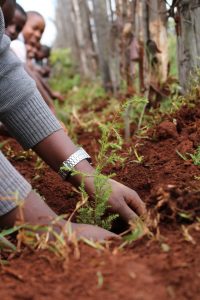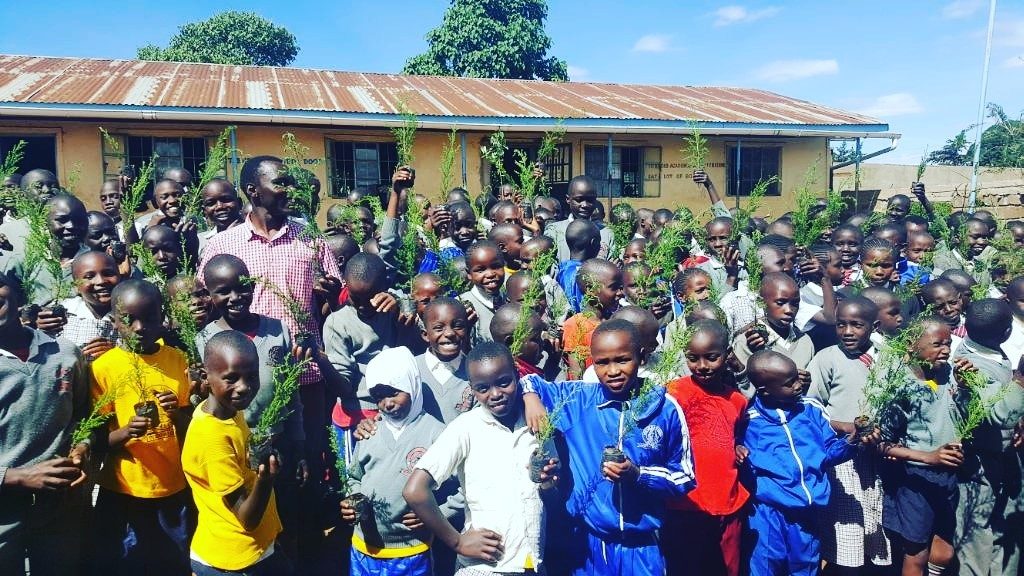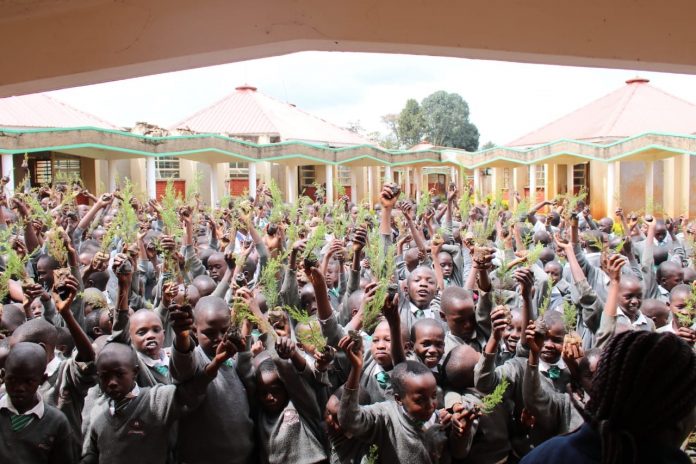“Children may not be able to participate in complex decision making regarding climate change but they can take simple actions like planting a tree as a way of addressing climate change,” Mr. Jeffrey, Team Leader, One Child One Tree Initiative.
As the world struggles with the consequences of global warming and climate change, every effort towards facilitating environmental protection is worthwhile. More so, where global and national macro-interventions are important, there is a need to support and promote micro-interventions that encourage the engagement of communities to promote environmental protection. It is vital that children are empowered to play their part in protecting the environment, by being good stewards and actively engaging in preserving our ecosystem.
Mr. Jeffrey Kosgei – the Team Leader, One Child One Tree Initiative is a motivated young Kenyan youth who is passionate about disseminating knowledge on SDGs to young people and their role in combating climate change. He explains more about his organization
Tell us more about one child one tree initiative…
The One Child One Tree initiative builds on sustainable development goals and aims to bring to the frontline the young generation to address climate change. We carry out environmental education among school children to bring out the importance of environmental conservation as one of the remedies for climate change and thereafter provide each pupil with one tree to plant and adopt for post-planting care.

What was your drive to venture into field sustainability?
Most of the actions taken to address climate change are always handled by the older generation leaving out the young generation. The need to involve the young generation which for a long time has been left out gave birth to the initiative. It is a fact that they will be the most affected group if nothing is done given that the effects of climate change are progressive. Children may not be able to participate in complex decision making regarding climate change but they can take simple actions like planting a tree as a way of addressing climate change. We are creating a platform for them to take action.
What is your concern about our ability as a country to create a more sustainable world?
Kenya has been lauded on its efforts to achieve sustainability and has cut an image globally. We are among the first countries globally to ban plastic bags and now plastic bottles in the protected areas. A look into the production of renewable energy and you will realize that we are moving in the right direction. For instance, we are the leading country in geothermal power production in Africa and among the top 10 globally. The wind and solar power energy are also expanding and no doubt this is the future of energy production.
Despite the merits, there is a need to have our government and private sector support innovations that enhance sustainability through technical and financial resources. We further need to create awareness among the population that sustainability can be achieved through our everyday activities.
We still have opportunities for the national government through the new curriculum to involve every school child in environmental education and the practical part of it which could include tree planting and other sustainable actions.
How have you embedded sustainable thinking within your organization?
 Having the school children take charge and be at the frontline in providing solutions to climate change is one way of ensuring a responsible generation. They will be conscious of the environment and will be responsible for their day to day actions. We are also nurturing young people who will be actively offering solutions to the challenges they face within their communities for they believe they too matter and can shape the course of their communities.
Having the school children take charge and be at the frontline in providing solutions to climate change is one way of ensuring a responsible generation. They will be conscious of the environment and will be responsible for their day to day actions. We are also nurturing young people who will be actively offering solutions to the challenges they face within their communities for they believe they too matter and can shape the course of their communities.
Highlights of projects your organization has engaged in
The initiative undertakes environmental education with an emphasis on climate change and environmental conservation. After the theory part, we facilitate a tree planting session where each school child plants and adopts one tree within their institution. Young people act as facilitators and volunteers of the program where they sharpen their leadership skills and deepen their knowledge on environmental matters.
So far the initiative has reached 3100 schoolchildren and close to 100 young people, teachers and board of management members in Nandi, Uasin Gishu and Nairobi County where each has planted and adopted one tree in their respective schools. Our latest project was at Korogocho Glory Primary school in Nairobi County where 350 school children planted one tree each within the school compound.
What factors do you consider when proposing a sustainability initiative or campaign?
Our objective as an organization is to create a platform for the young generation to take action. We consider the need for the project which tends to vary from one school to another. A school may be experiencing soil erosion on part of its land while another is affected by pollution. For example, our last project was at Korogocho Glory Primary School which is located along the Riverbanks of Nairobi River and it is adjacent to Dandora dumping site which is one of Africa’s largest dumping site. They experience a lot of air pollution as a result of composting mountains of toxic waste. For a long time, they have wanted to plant trees so that it can trap the smoke from directly reaching their classrooms and interrupting their lessons.
This reason informed our decision to select this school as the beneficiary of our project. It gave us the opportunity to educate them about environmental conservation, climate change and relate directly the detrimental impact it has on the environment and our lives.
Who supports the projects in your organization?

We have three avenues of ensuring our projects get the necessary resources. Majorly through our members’ voluntary donations which comes in terms of seedlings or finances to facilitate our activities. Secondly, from partnerships with like-minded organizations and government departments. This is advantageous since we learn from their side of the viewpoint. Finally, as a way of ensuring sustainability, we have established our own tree nursery beds where we are now working on having our own saplings.
What are some of the challenges you face as an organization working towards sustainability?
The huge cost that sometimes is involved in undertaking innovative ideas that would otherwise change our communities. Very few organizations are available to offer grants which leave us with limited options. A number of ideas never see the light of the day. We have had challenges getting affordable and quality seedlings especially in urban areas which end up limiting our activities.
Limited information in regards to sustainability which definitely reflects on the involvement of the public given that they don’t know its importance.
What piece of advice would you offer to others seeking to create change in the sustainable world?
They should never wait, let them step out, starting does not need money it needs passion. Young people should cultivate the art of partnerships and collaborations when addressing shared challenges in order to widen the scope of their impact.
Sustainability issues cuts across professions, therefore, it should never be an impediment, whether one is in the medical world or the tech world they can find their space to contribute to a sustainable world.
Finally, let the solution we put forward be relevant to challenges within our localities for you to increase your impact on society.




